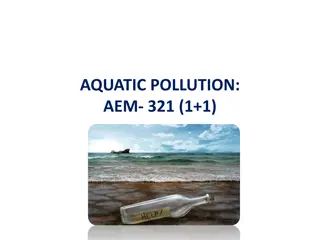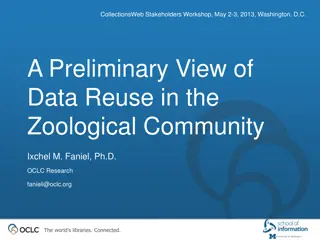Aquatic Treatment Systems for Wastewater Reclamation and Reuse
In aquatic systems, wastewater treatment involves bacterial metabolism and sedimentation, with aquatic plants playing a role in improving treatment capabilities. This article discusses the functions of aquatic plants in treatment systems and the categories of wetlands used for wastewater treatment, including natural wetlands, constructed wetlands, and aquatic plant systems. Wetlands offer physical pollutant entrapment, element transformation by microorganisms, and low-energy maintenance for consistent treatment levels, making them attractive for wastewater treatment.
Download Presentation

Please find below an Image/Link to download the presentation.
The content on the website is provided AS IS for your information and personal use only. It may not be sold, licensed, or shared on other websites without obtaining consent from the author. Download presentation by click this link. If you encounter any issues during the download, it is possible that the publisher has removed the file from their server.
E N D
Presentation Transcript
CE 445 Wastewater Reclamation and Reuse Dr. Mohab Kamal
Wetland Design Classification In aquatic systems, wastewater is treated principally by means of bacterial metabolism and physical sedimentation, as is the case in conventional activated sludge and trickling filter systems. The aquatic plants themselves bring about little actual treatment of the wastewater (4). Their function is generally to support components of the aquatic environment that improve the wastewater treatment capability and/or reliability of that environment (5). Some specific functions of aquatic plants in aquatic treatment systems are summarized in Table below The morphology of some typical aquatic plants is shown schematically in Figure below CE 445 Water Reclamation and Reuse (Dr. Mohab Kamal) 2
Functions of Aquatic Plants In Aquatic Treatment Systems CE 445 Water Reclamation and Reuse (Dr. Mohab Kamal) 3
Common aquatic plants CE 445 Water Reclamation and Reuse (Dr. Mohab Kamal) 4
Wetland Design Classification Wetlands are those areas that are inundated or saturated by surface or ground water at a frequency and duration sufficient to maintain saturated conditions. These can be either preexisting natural wetlands (e.g. marshes, swamps, bogs, cypress domes and strands, etc.) or constructed wetland systems. Constructed systems can range from creation of a marsh in a natural setting where one did not permanently exist before to intensive construction involving earth moving, grading, impermeable barriers or erection of containers such as tanks or trenches. The vegetation that is introduced or emerges from these constructed systems will generally be similar to that found in the natural wetlands CE 445 Water Reclamation and Reuse (Dr. Mohab Kamal) 5
Wetland Design Classification There are three basic functions of wetlands that make them potentially attractive for wastewater treatment: 1. Physical entrapment of pollutants through sorption in the surface soils and organic litter. 2. Utilization and transformation of elements by microorganisms. 3. Low energy and low maintenance requirements to attain consistent treatment levels. Three major systems involving wastewater and wetlands can be observed in the United States (9). 1. Disposal of treated effluent into natural wetlands 2. Use of effluents or partially treated wastewater for enhancement, restoration, or creation of wetlands 3. Use of constructed wetlands for wastewater treatment CE 445 Water Reclamation and Reuse (Dr. Mohab Kamal) 6
Wetland Design Classification There are three categories of aquatic treatment systems considered in this manual: Natural Wetlands Constructed Wetlands Aquatic Plant Systems CE 445 Water Reclamation and Reuse (Dr. Mohab Kamal) 7
Natural Wetlands While the interest in wetlands for wastewater treatment is fairly recent, the term wetlands is also a relatively new expression, encompassing what for years have simply been referred to as marshes, swamps, or bogs. The difference in these wetlands is related to a large extent to the vegetation which dominates the area. Grasses or forbs are generally dominant in marshes, trees and shrubs characterize swamps, and sedge/peat vegetation occurs in various bogs. Natural wetlands are effective as wastewater treatment processes for a number of reasons. Natural wetlands support a large and diverse population of bacteria which grow on the submerged roots and stems of aquatic plants and are of particular importance in the removal of BOD5 from wastewater. In addition, the calm water conditions of a wetland are conducive to the sedimentation of wastewater solids. Other aspects of wetlands that facilitate wastewater treatment are the adsorption/filtration potential of the aquatic plants roots and stems, the ion exchange/adsorption capacity of wetlands natural sediments, and the mitigating effect that the plants themselves have on climatic forces such as wind, sunlight and temperature. CE 445 Water Reclamation and Reuse (Dr. Mohab Kamal) 8
Natural Wetlands Natural wetland systems are typically characterized by emergent aquatic vegetation such as cattails (Typha), rushes (Scirpus), and reeds (Phragmites). They can also contain some of the floating and submerged plant species as well as phreatophytes (plants whose roots extend to the ground-water table or the saturated soil area immediately above it). CE 445 Water Reclamation and Reuse (Dr. Mohab Kamal) 9
Constructed Wetlands Constructed wetlands are either free water surface systems (FWS) with shallow water depths or subsurface flow systems (SFS) with water flowing laterally through the sand or gravel. Constructed wetlands have the positive characteristics of a natural wetland and can also be controlled to eliminate the negative aspects of natural wetlands. Bacteria attached to plant stems and the humic deposits are the major factor for BOD5 removal. With respect to phosphorus removal, the contact opportunities with the soil are limited in most natural wetland systems (an exception might be peat bogs) and release of phosphorus has been observed during the winter in some cases. The surface area for constructed marshes ranges from 24.6 to 39.6 m2/m3 of applied wastewater per day (23-37 ac/mgd). The major costs and energy requirements for constructed wetlands are associated with preapplication treatment, pumping and transmission to the site, distribution at the site, minor earthwork, and land costs. In addition, a constructed system may require the installation of a barrier layer to limit percolation to groundwater and additional containment structures in case of flooding. CE 445 Water Reclamation and Reuse (Dr. Mohab Kamal) 10
Constructed Wetlands Possible constraints to the use of constructed wetlands for wastewater treatment include the following: Geographical limitations of plant species, as well as the potential that a newly introduced plant species will become a nuisance or an agricultural competitor. Constructed wetlands that discharge to surface water require 4 to 10 times more land area than a conventional wastewater treatment facility. Zero discharge constructed wetlands require 10 to 100 times the area of conventional wastewater treatment plants. Plant biomass harvesting is constrained by high plant moisture content and wetland configuration. Some types of constructed wetlands may provide breeding grounds for disease producing organisms and insects and may generate odors if not properly managed. CE 445 Water Reclamation and Reuse (Dr. Mohab Kamal) 11
Constructed Wetlands Free Water Surface Systems (FWS) These systems typically consist of basins or channels, with some sort of subsurface barrier to prevent seepage, soil or another suitable medium to support the emergent vegetation, and water at a relatively shallow depth flowing through the unit. The shallow water depth, low flow velocity, and presence of the plant stalks and litter regulate water flow and, especially in long, narrow channels minimize short circuiting. CE 445 Water Reclamation and Reuse (Dr. Mohab Kamal) 12
Constructed Wetlands Subsurface Flow Systems (SFS) These systems are essentially horizontal trickling filters when they use rock media. They have the added component of emergent plants with extensive root systems within the media. Systems using sand or soil media are also used. Unlike the FWS system equation, in which the specific surface area is important but not critical, the media porosity is critical to predicting the required area for a given level of treatment. Media porosity has a direct mathematical relationship with the microbial degradation rate constant. CE 445 Water Reclamation and Reuse (Dr. Mohab Kamal) 13
Aquatic Plant Systems Floating Plant Systems The water hyacinth Eichhornia crassipes has been studied extensively for use in improving the wastewater effluent from oxidation ponds and as the major component in an integrated, advanced wastewater treatment system. The major characteristics of water hyacinths that make them an attractive biological support media for bacteria are their extensive root system and rapid growth rate. The major characteristic that limits their widespread use is their temperature sensitivity (i.e., they are rapidly killed by winter frost conditions.) Duckweed systems have been studied alone and as components of water hyacinths in polyculture systems. CE 445 Water Reclamation and Reuse (Dr. Mohab Kamal) 14
Aquatic Plant Systems Submerged Plant Systems Submerged plants are either suspended in the water column or rooted in the bottom sediments. Typically, their photosynthetic parts are in the water column. The potential for use of submerged plants for polishing of effluent seems at least theoretically an attractive option. The tendency of these plants to be shaded out by algal growths and to be killed or severely harmed by anaerobic conditions limits their practical usefulness. CE 445 Water Reclamation and Reuse (Dr. Mohab Kamal) 15























